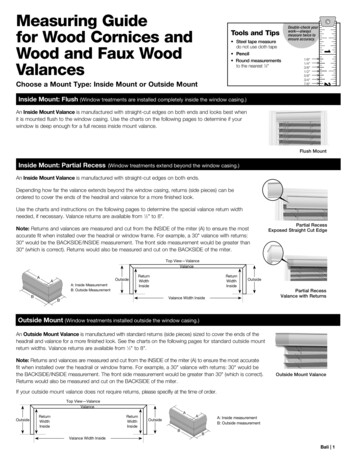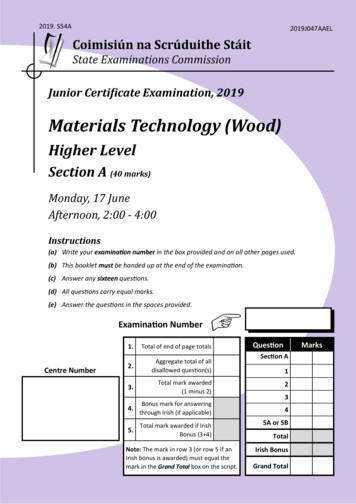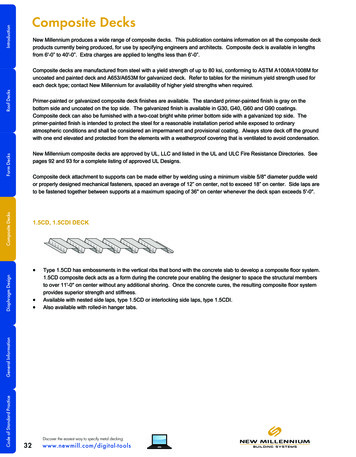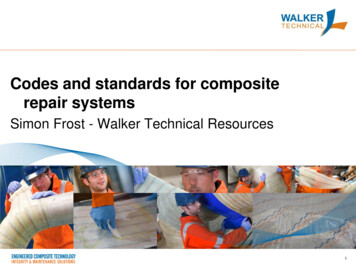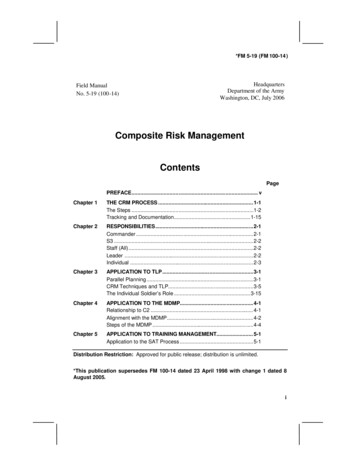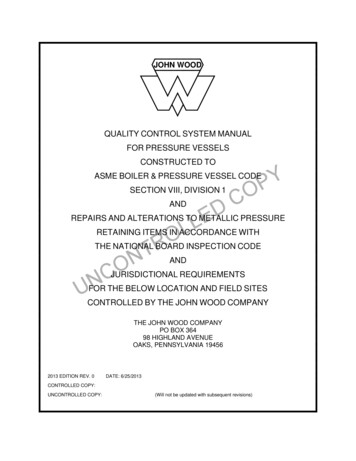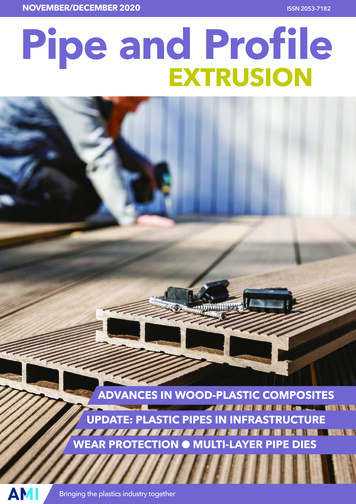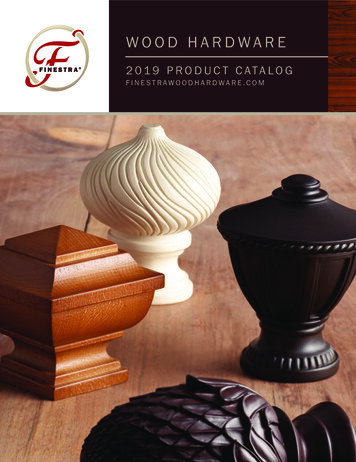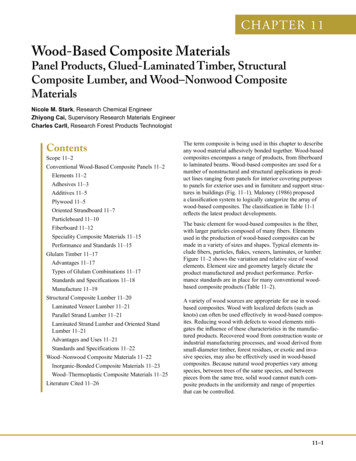
Transcription
CHAPTER 11Wood-Based Composite MaterialsPanel Products, Glued-Laminated Timber, StructuralComposite Lumber, and Wood–Nonwood CompositeMaterialsNicole M. Stark, Research Chemical EngineerZhiyong Cai, Supervisory Research Materials EngineerCharles Carll, Research Forest Products TechnologistContentsScope 11–2Conventional Wood-Based Composite Panels 11–2Elements 11–2Adhesives 11–3Additives 11–5Plywood 11–5Oriented Strandboard 11–7Particleboard 11–10Fiberboard 11–12Speciality Composite Materials 11–15Performance and Standards 11–15Glulam Timber 11–17Advantages 11–17Types of Glulam Combinations 11–17Standards and Specifications 11–18Manufacture 11–19Structural Composite Lumber 11–20Laminated Veneer Lumber 11–21Parallel Strand Lumber 11–21Laminated Strand Lumber and Oriented StandLumber 11–21Advantages and Uses 11–21Standards and Specifications 11–22Wood–Nonwood Composite Materials 11–22Inorganic-Bonded Composite Materials 11–23Wood–Thermoplastic Composite Materials 11–25Literature Cited 11–26The term composite is being used in this chapter to describeany wood material adhesively bonded together. Wood-basedcomposites encompass a range of products, from fiberboardto laminated beams. Wood-based composites are used for anumber of nonstructural and structural applications in product lines ranging from panels for interior covering purposesto panels for exterior uses and in furniture and support structures in buildings (Fig. 11–1). Maloney (1986) proposeda classification system to logically categorize the array ofwood-based composites. The classification in Table 11-1reflects the latest product developments.The basic element for wood-based composites is the fiber,with larger particles composed of many fibers. Elementsused in the production of wood-based composites can bemade in a variety of sizes and shapes. Typical elements include fibers, particles, flakes, veneers, laminates, or lumber.Figure 11–2 shows the variation and relative size of woodelements. Element size and geometry largely dictate theproduct manufactured and product performance. Performance standards are in place for many conventional woodbased composite products (Table 11–2).A variety of wood sources are appropriate for use in woodbased composites. Wood with localized defects (such asknots) can often be used effectively in wood-based composites. Reducing wood with defects to wood elements mitigates the influence of these characteristics in the manufactured products. Recovered wood from construction waste orindustrial manufacturing processes, and wood derived fromsmall-diameter timber, forest residues, or exotic and invasive species, may also be effectively used in wood-basedcomposites. Because natural wood properties vary amongspecies, between trees of the same species, and betweenpieces from the same tree, solid wood cannot match composite products in the uniformity and range of propertiesthat can be controlled.11–1
General Technical Report FPL–GTR–190Table 11–1. Classification of woodbased compositesaVeneer-based materialPlywoodLaminated veneer lumber (LVL)Parallel-strand lumber (PSL)LaminatesGlue-laminated timbersOverlayed materialsLaminated wood–nonwood compositesbMultiwood composites (COM-PLYc)Composite materialFiberboard (low-, medium-, or high-density)Cellulosic rdOriented strandboard (OSB)Laminated strand lumber (LSL)Oriented strand lumber (OSL)Wood–nonwood compositesWood fiber–polymer compositesInorganic-bonded compositesaAdapted from Maloney (1986).Panels or shaped materials combined with nonwoodmaterials such as metal, plastic, and fiberglass.cRegistered trademark of APA–The EngineeredWood Association.bScopeThis chapter gives an overview of the general types andcomposition of wood-based composite products and the materials and processes used to manufacture them. It describesconventional wood-based composite panels and structuralcomposite materials intended for general construction,interior use, or both. This chapter also describes wood–nonwood composites. Mechanical properties of these typesof composites are presented and discussed in Chapter 12.Because wood-based composites come in a variety of forms,we briefly describe several of the most common commercialproducts.This chapter is organized into three sections. The first section covers conventional wood-based composite panels.Materials, adhesives, and additives common to conventionalwood-based composites are summarized. Specific productsaddressed include panel products such as plywood, orientedstrandboard, particleboard, and fiberboard. Specialtycomposites are also discussed. The second section coversstructural composite lumber, including glued-laminatedtimber, laminated veneer lumber, parallel strand lumber,laminated strand lumber, and oriented strand lumber. Wood–nonwood composites are discussed in the third section,including inorganic-bonded composites and wood–thermoplastic composites. Books have been written about each of11–2Figure 11–1. Wood-based composites used in the newCentennial Research Facility at the Forest ProductsLaboratory. Glulam timbers support composite I-joistsand plywood sheathing. (Photo by Steve Schmieding,Forest Products Laboratory.)these categories, and the constraints of this chapter necessitate that the discussion be general and brief. References areprovided for more detailed information.Conventional Wood-BasedComposite PanelsConventional wood-based composites are manufacturedproducts made primarily from wood with only a few percentresin and other additives. A useful way to classify conventional wood-based composites based on specific gravity,density, raw material, and processing methods is shown inFigure 11–3, which presents an overview of the most common types of commercial panel products discussed in thischapter and a quick reference to how these composite materials compare with solid wood from the standpoint of density and general processing considerations. The raw materialclassifications of fibers, particles, and veneers are shown onthe left y-axis. Specific gravity and density are shown onthe top and bottom horizontal axes (x-axes), respectively.The right y-axis, wet and dry processes, describes in generalterms the processing method used to produce a particularproduct. Selection of wood elements, adhesives, and processing techniques all contribute to product performance.Figure 11–4 shows examples of some commercial woodbased composites.ElementsThe primary component of wood-based composites is thewood element, often 94% or more by mass. Common elements for conventional wood-based composites includeveneers, strands, particles, and fibers. The physical characteristics of common elements can be seen in Figure 11–5.Properties of composite materials can be changed by changing the size and geometry of the elements and by combining, reorganizing, or stratifying elements.
Chapter 11 Wood-Based Composite MaterialsTable 11–2. Commercial product or performance standards for wood-based compositesProduct categoryApplicable standardName of standardSourcePlywoodPS 1–07Voluntary product standard PS 1–07construction and industrial plywoodNIST 2007PS 2–04Voluntary product standard PS 2–04performance standard for wood-basedstructural-use panelsNIST 2004HP–1–2004Voluntary product standardHP–1–2004 hardwood and decorativeplywoodHPVA 2004Oriented strandboard PS 2–04(OSB)Voluntary product standard PS 2–04performance standard for wood-basedstructural-use panelsNIST 2004ParticleboardANSI A 208.1–2009Particleboard standardCPA 2009aFiberboardANSI A 208.2–2009ANSI A 135.4–2004ANSI A 135.5–2004ANSI A 135.6–2006ASTM C 208–08aMDF standardBasic hardboardPre-finished hardboard panelingHardboard sidingCellulosic fiberboardCPA 2009bCPA 2004aCPA 2004bCPA 2006ASTM 2008cGlued-laminatedtimber (glulam)ANSI/AITC 190.1American National Standard for WoodProducts—structural glued-laminatedtimberAITC 2007aStructural compositelumber (includinglaminated veneerlumber (LVL),laminated strandlumber (LSL), andparallel strandlumber (PSL))ASTM D 5456–07Standard specification for evaluationof structural composite lumber productsASTM 2008bAdhesivesBonding in most conventional wood-based compositesis provided by thermosetting (heat-curing) adhesiveresins. Chapter 9 provides a more thorough discussion ofthermoset adhesive resins. Commonly used resin–bindersystems include phenol-formaldehyde, urea-formaldehyde,melamine-formaldehyde, and isocyanate.Phenol-FormaldehydePhenol-formaldehyde (PF) resins are typically used in themanufacture of construction plywood and oriented strandboard where exposure to weather during construction is aconcern. Other moisture exposure situations, such as temporary weather exposure, occasional plumbing leaks, or wetfoot traffic, may also necessitate the use of PF resins. PFresins are commonly referred to as phenolic resins. Phenolicresins are relatively slow-curing compared with other thermosetting resins. In hot-pressed wood-based composites,use of phenolic resin necessitates longer press times andhigher press temperatures. Hot-stacking of pressed materialshortly after emergence from the press is a fairly commonindustrial practice, used to attain adequate resin cure without greatly extending press time. Significant heat exposureassociated with pressing of phenolic-bonded compositescommonly results in a noticeable reduction in their hygroscopicity. Cured phenolic resins remain chemically stableat elevated temperatures. Their bonds also are sometimesreferred to as being “boil-proof” because of their ability tomaintain composite dimensional and mechanical propertiesunder wet conditions. The inherently darker color of PF resin compared with other resins may make them aestheticallyunsuitable for product applications such as interior panelingand furniture.Urea-FormaldehydeUrea-formaldehyde (UF) resins are typically used in themanufacture of products used in interior applications, primarily particleboard and medium-density fiberboard (MDF),because moisture exposure leads to a breakdown of thebond-forming reactions. Excessive heat exposure will alsoresult in chemical breakdown of cured UF resins, thereforeUF-bonded panels are typically cooled after emergence11–3
General Technical Report FPL–GTR–190Figure 11–2. Basic wood elements, from largest to smallest (Kretschmann and others 2007).from the press. Advantages of UF resins include lower curing temperatures than PF resins and ease of use under avariety of curing conditions. UF resins are the lowest costthermosetting adhesive resins. They offer light color, whichoften is a requirement in the manufacture of decorativeproducts. However, the release of formaldehyde from products bonded with UF is a growing health concern.Melamine-FormaldehydeMelamine-formaldehyde (MF) resins are used primarilyfor decorative laminates, paper treating, and papercoating. They are typically more expensive than PF resins.MF resins may, despite their high cost, be used in bondingconventional wood-based composites. MF resins are oftenused in combination with UF. MF–UF resins are used whenan inconspicuous (light color) adhesive is needed and whengreater water resistance than can be attained with UF resinis required.IsocyanatesThe isocyanate wood adhesive is a polymeric methylene diisocyanate (pMDI). It is used as an alternative to PF resin,primarily in composite products fabricated from strands.pMDI resins are typically more costly than PF resins buthave more rapid cure rates and will tolerate higher moisturecontents in the wood source. pMDI resin is sometimes usedin core layers of strand-based composites, with slowercuring PF resin used in surface layers. Facilities that use11–4pMDI are required to take special precautionary protectivemeasures because the uncured resin can result in chemicalsensitization of persons exposed to it. Cured pMDI resinposes no recognized health concerns.Bio-Based AdhesivesBio-based adhesives, primarily protein glues, were widelyused prior to the early 1970s in construction plywood. In themid-1970s, they were supplanted by PF adhesives, on thebasis of the superior bond durability provided by phenolics.The move toward “green” products has led to a renewedinterest in bio-based adhesives. Several soy-protein-basedresin systems, with bond durabilities similar to those provided by PF resins, have recently been developed and commercialized. Durable adhesive systems may also be derivedfrom tannins or from lignin. Tannins are natural phenolcompounds that are present in the bark of a number of treespecies. The tannins can be extracted from bark, modified,and reacted with formaldehyde to produce an intermediate polymer that is a satisfactory thermosetting adhesive.Lignin-based resins have also been developed from spentpulping liquor, which is generated when wood is pulped forpaper or chemical feedstocks. In the manufacture of wetprocess fiberboard, lignin, which is an inherent componentof lignocellulosic material, is frequently used as binder(Suchsland and Woodson 1986), although “natural” ligninbonding is sometimes augmented with small amounts ofPF resin.
Chapter 11 Wood-Based Composite MaterialsFigure 11–3. Classification of wood composite panels by particle size, density, and process(Suchsland and Woodson 1986). Note that insulation board is now known as cellulosic fiberboard.Resin ChoiceOften a particular resin will dominate for a particular product, but each has its advantages. Factors taken into accountinclude materials to be bonded together, moisture contentat time of bonding, mechanical property and durability requirements of the composite products, anticipated end-useof the product, and resin system costs.PF, UF, and pMDI resins systems are expected to remainthe dominant adhesives used for bonded wood-basedcomposites. However, cost and reliable availability ofpetrochemicals may affect the relative predominance of PF,UF, and pMDI adhesives versus bio-based adhesives. Morestringent regulation concerning emissions from formaldehyde-containing products (driven by concern over indoor airquality) may affect the continued commercial predominanceof UF resin in interior products. For example, the CaliforniaAir Resources Board (CARB) has established formaldehydeemission standards that cover hardwood plywood, particleboard, and MDF. As a result, bio-based adhesive and resinsystems may gain market share compared with petroleumbased synthetic resins.AdditivesA number of additives are used in the production of conventional composite products. The most common additiveis wax, which is used to provide products with some resistance to liquid water absorption. In flake-, particle-, andfiberboard products, wax emulsions provide limited-termwater resistance and dimensional stability when the board iswetted. Even small amounts (0.5% to 1%) act to retard therate of liquid water pickup for limited time periods. Theseimproved short-term water penetration properties are important for ensuring the success of subsequent secondary gluingoperations and for providing protection upon accidental wetting of the product during and after construction. The addition of wax has practically no effect on water vapor sorptionor dimensional changes associated with changes in humidity. Other additives used for specialty products includepreservatives, moldicides, and fire retardants. Compositescontaining additives are more thoroughly discussed in thesection on Specialty Composite Materials.PlywoodPlywood is a panel product built up wholly or primarily ofsheets of veneer called plies. It is constructed with an oddnumber of layers with the grain direction of adjacent layersoriented perpendicular to one another. A layer can consistof a single ply or of two or more plies laminated with theirgrain direction parallel. A panel can contain an odd or evennumber of plies but always an odd number of layers. Theoutside plies are called faces, or face and back plies. Innerplies are plies other than the face or back plies. The outerlayers and all odd-numbered layers have their grain direction oriented parallel to the long dimension of the panel. Thegrain in even-numbered layers is perpendicular to the lengthof the panel. Inner plies whose grain direction runs parallelto that of the faces are termed “centers” whereas inner plies11–5
General Technical Report FPL–GTR–190Figure 11–4. Examples of various composite products. From top left, clockwise: LVL, PSL, LSL, plywood, OSB, particleboard, and fiberboard.Plywood is also used as a component in other engineeredwood products and systems in applications such as prefabricated I-joists, box beams, stressed-skin panels, and panelized roofs.Figure 11–5. Common wood elements used in woodbased composites from top left, clockwise: shavings,sawdust, fiber, large particles, wafers, and strands.whose grain direction runs perpendicular to that of the facesare termed “crossbands.” To distinguish the number of plies(individual sheets of veneer in a panel) from the numberof layers (number of times the grain orientation changes),panels are sometimes described as three-ply, three-layer orfour-ply, three-layer, etc. The center layer may be veneer,lumber, particleboard, or fiberboard; however, all-veneerconstruction is most common in construction and industrialplywood.Plywood panels are used in various applications, includingconstruction sheathing, furniture, and cabinet panels.11–6CharacteristicsThe properties of plywood depend on the quality of theveneer plies, the order of layers, the adhesive used, and thedegree to which bonding conditions are controlled duringproduction. The durability of the adhesive-to-wood bonddepends largely on the adhesive used but also on control ofbonding conditions and on veneer quality. The grade of thepanel depends upon the quality of the veneers used, particularly of the face and back.Plywood panels have significant bending strength bothalong the panel and across the panel, and the differences instrength and stiffness along the panel length versus acrossthe panel are much smaller than those differences in solidwood. Plywood also has excellent dimensional stabilityalong its length and across its width. Minimal edge-swellingmakes plywood a good choice for adhesive-bonded tongueand-groove joints, even where some wetting is expected.Unlike most panels fabricated from particles, it undergoesminimal irreversible thickness swelling if wetted. The alternating grain direction of its layers makes plywood resistantto splitting, allowing fasteners to be placed very near theedges of a panel. In uses where internal knotholes and voidsmay pose a problem, such as in small pieces, plywood canbe ordered with a solid core and face veneers.
Chapter 11 Wood-Based Composite MaterialsClasses of PlywoodTwo classes of plywood are commonly available, coveredby separate standards: (a) construction and industrial plywood and (b) hardwood and decorative plywood.Most construction and industrial plywood used in the UnitedStates is produced domestically, and U.S. manufacturersexport some material. The bulk of construction and industrial plywood is used where performance is more importantthan appearance. However, some grades of construction andindustrial plywood are made with faces selected primarilyfor appearance and are used either with clear natural finishesor lightly pigmented finishes. Construction and industrialplywood has traditionally been made from softwoods suchas Douglas-fir and southern yellow pine. However, true firs,western hemlock, and western pines are also used (Bowyerand others 2007). A large number of hardwoods qualify foruse under the standard. PF resin is the primary adhesive typeused in construction and industrial plywood. Constructionand industrial plywood is categorized by exposure capabilityand grade using Voluntary Product Standard PS 1–07 (NIST2007).Hardwood and decorative plywood is made of many different species, both in the United States and overseas. Wellover half of all panel
The term composite is being used in this chapter to describe any wood material adhesively bonded together. Wood-based composites encompass a range of products, from fiberboard to laminated beams. Wood-based composites are used for a number of nonstructural and structural applications in prod-Cited by: 132Page Count: 28File Size: 1MBAuthor: Nicole M.
